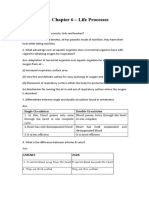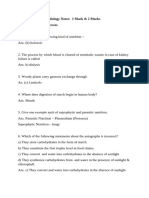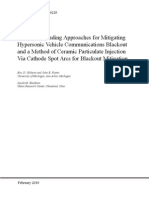Comparing Various Closed Circulatory Systems: Mammals Frogs Fish
Comparing Various Closed Circulatory Systems: Mammals Frogs Fish
Uploaded by
rishadabubeckerCopyright:
Available Formats
Comparing Various Closed Circulatory Systems: Mammals Frogs Fish
Comparing Various Closed Circulatory Systems: Mammals Frogs Fish
Uploaded by
rishadabubeckerOriginal Description:
Original Title
Copyright
Available Formats
Share this document
Did you find this document useful?
Is this content inappropriate?
Copyright:
Available Formats
Comparing Various Closed Circulatory Systems: Mammals Frogs Fish
Comparing Various Closed Circulatory Systems: Mammals Frogs Fish
Uploaded by
rishadabubeckerCopyright:
Available Formats
Comparing Various Closed
Circulatory Systems
Mammals Frogs Fish
Circulation in Mammals (and birds)
Double circulation
FROG
Questions
1a) How many of each kind of chamber does a
frog's heart have?
b) Compare and Contrast the functioning of the
frogs heart with that of a mammal.
c) The diagram of the path of circulation in a frog
(above) shows that there is an extensive blood
supply to the body wall. Frog's skin is usually
moist. Frogs can spend considerable time under
water. How could this type of circulation be an
advantage when the frog is underwater?
Frog
Double Circulation
FROG: Circulatory System
Answers
1a) How many of each kind of chamber does a frog's heart have?
Three chambers: 1 Ventricle and 2 Atria
b) Compare and Contrast the functioning of the frogs heart with that of a
mammal.
They are similar in that both have a right and left atria that function to
receive blood and pump it to the ventricle (s).
But they differ in that oxygen rich and poor blood mix in the ventricle
of the frog and the ventricle functions to send blood with a relatively
low oxygen concentration (compared to in a mammal) to the tissues
of the body.
Mammals dont have blood returning from the body and the lungs
mixing; they are kept in separate ventricles and so only oxygen rich
blood from the left ventricle is distributed to the tissues of the body.
So Blood moving to body tissue will contain less oxygen per unit of
volume than mammalian blood
Cont.
c) ..How could this type of circulation be an
advantage when the frog is underwater?
Oxygen (from the water) can be absorbed
across the moist skin of the frog when it is
under water (and cant use its lungs for gas
exchange). (Oxygen enables aerobic
respiration to proceed and thus ATP to be
produced without waste such as lactic acid
accumulating.)
FISH
Questions
2 a) How many of each type of chamber does the heart of a
fish have?
b) Fish have a single circulation as compared to the double
circulation of mammals. Examine the diagram of the
path of circulation in a fish (above) and explain what is
meant by a single circulation.
c) Suggest a possible advantage of a double circulatory
system over a single circulatory system.
d) Why is a single circulatory system effective for a fish,
when it would be ineffective for a mammal?
Fish
Single circulation
Low
pressure
FISH: Circulatory System Question
2a) How many of each type of chamber does the heart of a fish have?
1 atrium and 1 ventricle
b) Fish have a single circulation as compared to the double circulation
of mammals. Examine the diagram of the path of circulation in a
fish (above) and explain what is meant by a single circulation.
Blood moves through the heart only once in each complete circuit
around the body. It goes from heart to gills and from gills to the
rest of the body. (as opposed to double circulation which involves
the blood passing through the heart twice in each complete
circulation of the body. It is returned to the heart after being
reoxygenated at the lungs, before being pumped to the rest of the
body)
c) Suggest a possible advantage of a double circulatory system over a
single circulatory system
(i) The heart receives blood which is oxygen rich. The heart is a muscle
and muscle tissue being active requires a rich supply of oxygen so that
ATP can be generated during aerobic respiration
(ii) Freshly oxygenated blood will then be pumped by the heart to other
tissues of the body. This pumping forces the blood along and ensures
rapid delivery to tissues.
(single circulation in comparison means the actual heart tissue only
receives oxygen poor blood and that blood pumped to other tissues is
under low pressure and is delivered fairly inefficiently
d) Why is a single circulatory system effective for a fish, when it would be
ineffective for a mammal.
Fish are poikilothermic ectotherms (their body temp fluctuates with that
of the environment and they dont adjust their production of metabolic
heat) and less metabolically active than mammals. Thus their tissues
require less ATP to fulfill their needs, thus oxygen and glucose can be
supplied at a slower rate for the respiration to still be sufficient.
Mammals are homeothermic endotherms (maintain a stable core
temperature and control generation on metabolic heat to do so) and
more metabolically active and need to supply oxygen and glucose to
cells more efficiently to enable supply of ATP fast enough to sustain
their cells
You might also like
- BUSINESS PLAN (POTATO CORNER) Cacholaa, Eduard JR SDocument13 pagesBUSINESS PLAN (POTATO CORNER) Cacholaa, Eduard JR SMichael Zinampan60% (5)
- The Deck: The Timeline Deck Contains 54 Cards (Just Like A: Contained in This GameDocument5 pagesThe Deck: The Timeline Deck Contains 54 Cards (Just Like A: Contained in This GameMarcos ScatolinoNo ratings yet
- John RustDocument273 pagesJohn RustHANSANEENo ratings yet
- Comparative Anatomy of Heart, Circulation Aortic Arches EtcDocument36 pagesComparative Anatomy of Heart, Circulation Aortic Arches EtcNarasimha Murthy100% (4)
- FAQ BiologyDocument25 pagesFAQ Biologyamit21oct2005No ratings yet
- BiologyDocument28 pagesBiologyrdgaefaNo ratings yet
- Lesson 1 - Mass Transport Systems WorkshetDocument2 pagesLesson 1 - Mass Transport Systems WorkshetpapwortheNo ratings yet
- AS Biology F211 Animal Transport Workbooklet Answers p1-10Document11 pagesAS Biology F211 Animal Transport Workbooklet Answers p1-10T-Jay Ellis-DaleNo ratings yet
- Part-C BiologyDocument40 pagesPart-C Biologypriyajd2104No ratings yet
- VIII Biology HO 3Document2 pagesVIII Biology HO 3Sangita PervinNo ratings yet
- CHP 5 Form 5 InheritanceDocument10 pagesCHP 5 Form 5 InheritancepuvanesvaranNo ratings yet
- Nicolás Naves 12.2 Amniote HeartDocument3 pagesNicolás Naves 12.2 Amniote HeartYuji IdeNo ratings yet
- Imp Qs HYEDocument14 pagesImp Qs HYEANIKA PRASHANTKUMAR JAISWALNo ratings yet
- Transportationof 10Document2 pagesTransportationof 10Priyanshu MurariNo ratings yet
- Circulatory SystemDocument2 pagesCirculatory Systemapi-522789883No ratings yet
- 2C1 Circulatory SystemsDocument17 pages2C1 Circulatory SystemsAsmaNo ratings yet
- Animal Circulatory SystemDocument6 pagesAnimal Circulatory Systemnndkasnd sdfoashdfNo ratings yet
- Life Processes NotesDocument10 pagesLife Processes NotesKarishmm KulkarniNo ratings yet
- Biology (E) 2024Document48 pagesBiology (E) 2024Gowtham Reddy100% (1)
- Circulatory System ReportDocument7 pagesCirculatory System ReportsathishkumarNo ratings yet
- Cbse Class 10th Chapter 6. Life Processes Solved QuestionsDocument5 pagesCbse Class 10th Chapter 6. Life Processes Solved QuestionsDeepakNo ratings yet
- Coursedocs Wwka7st7Document13 pagesCoursedocs Wwka7st7asma fathimaNo ratings yet
- Worksheet 4 On Transportation (Circulatory System)Document2 pagesWorksheet 4 On Transportation (Circulatory System)Naruto UzumakiNo ratings yet
- Lesson No 18Document8 pagesLesson No 18Moideen MoideenvtmsNo ratings yet
- Uace Biology Transport QuestionsDocument29 pagesUace Biology Transport Questionsatyamderrick100% (1)
- Biology Form 5 Notes Chapter 1Document39 pagesBiology Form 5 Notes Chapter 1Mayghen SelvanayagamNo ratings yet
- Form 5 Biology Chapter 1 TransportDocument12 pagesForm 5 Biology Chapter 1 TransportMohdAmerAhmadNo ratings yet
- Question and Answer of Animal PhysiologyDocument14 pagesQuestion and Answer of Animal PhysiologyNuni Rismayanti NurQalbi0% (1)
- BIO2 - 4.04 - ANIMAL GAS EXCHANGE AND CIRCULATION (v.2023 WITH VITAL SIGN MONITORING)Document80 pagesBIO2 - 4.04 - ANIMAL GAS EXCHANGE AND CIRCULATION (v.2023 WITH VITAL SIGN MONITORING)MARKIEL JUSTINE DOMOSMOGNo ratings yet
- Homeostasis KidneyDocument5 pagesHomeostasis Kidneysofia.salasprNo ratings yet
- Animal Circulatory SystemDocument14 pagesAnimal Circulatory System'Immey Ssi MoyNo ratings yet
- Cardiovascular SystemDocument4 pagesCardiovascular Systemrenyrick.manalotoNo ratings yet
- Life MindDocument9 pagesLife Mindmorningn354No ratings yet
- NOTES LIFE PROCESSES (Respiration, ExcretionDocument3 pagesNOTES LIFE PROCESSES (Respiration, ExcretionGokulVijayGopal G10No ratings yet
- AJAY-9971313179: (Tutor Marked Assignment) Course Code: LSE-05 Assignment Code: LSE-05/TMA/2020Document22 pagesAJAY-9971313179: (Tutor Marked Assignment) Course Code: LSE-05 Assignment Code: LSE-05/TMA/2020Rajni KumariNo ratings yet
- Amphibian Circulation - The FrogDocument15 pagesAmphibian Circulation - The FrogaraneyaNo ratings yet
- Amphibian Circulation - The FrogDocument15 pagesAmphibian Circulation - The FroghaasNo ratings yet
- 9.1 Transport in AnimalsDocument5 pages9.1 Transport in AnimalsNathan TeferaNo ratings yet
- Class-12 (RBSE) Biology-Ch-24 Blood Circulatory System PDFDocument7 pagesClass-12 (RBSE) Biology-Ch-24 Blood Circulatory System PDFIshansi AgrawalNo ratings yet
- X - Biology - Chapter 6 - Life Processes: 2 MarksDocument11 pagesX - Biology - Chapter 6 - Life Processes: 2 Marksvalliammai thiagarajanNo ratings yet
- M.SC 1 Sem Paper 2Document18 pagesM.SC 1 Sem Paper 2Anju yadavNo ratings yet
- Evolution of The HeartDocument4 pagesEvolution of The HeartLibEgalFratNo ratings yet
- Life Processes Question AnswersDocument7 pagesLife Processes Question AnswersNimrat VirkNo ratings yet
- Adaptations of The Heart (HL) - IB DP Biology SL - HL FE2025 (NEW)Document11 pagesAdaptations of The Heart (HL) - IB DP Biology SL - HL FE2025 (NEW)wassim.barghachounNo ratings yet
- G10 PT2 Revision Worksheet 2Document4 pagesG10 PT2 Revision Worksheet 2liveproajsquadNo ratings yet
- Animal's Circulartory System.Document2 pagesAnimal's Circulartory System.CHANON KIATKAWINWONGNo ratings yet
- Sapang Palay National High School: Senior High School General Biology Ii: Laboratory Report Per Group (May 24, 2023)Document4 pagesSapang Palay National High School: Senior High School General Biology Ii: Laboratory Report Per Group (May 24, 2023)Philia MesoriaNo ratings yet
- Biology - Life ProcessesDocument17 pagesBiology - Life ProcessesAnuradha ChauhanNo ratings yet
- Class CephalopodsDocument8 pagesClass Cephalopodsregine cernaNo ratings yet
- Life Process Revision WorksheetDocument6 pagesLife Process Revision WorksheetAdithya VinodNo ratings yet
- Class X Physics NCERT Solution by NTSE GuruDocument6 pagesClass X Physics NCERT Solution by NTSE GuruNTSE GuruNo ratings yet
- Circulatory System of Animals PDFDocument18 pagesCirculatory System of Animals PDFcheskja ramosNo ratings yet
- Circulatory System FrogDocument9 pagesCirculatory System FrogLeticiaNo ratings yet
- Circulation in AnimalsDocument38 pagesCirculation in Animalsvuminhtut66No ratings yet
- Transport in InvertebratesDocument10 pagesTransport in InvertebratesketakeeNo ratings yet
- Assignment-Ch 11-Ans SheetDocument6 pagesAssignment-Ch 11-Ans Sheetrachna sharmaNo ratings yet
- Transportation: (Textbook PG 78 - PG 113)Document38 pagesTransportation: (Textbook PG 78 - PG 113)ernNo ratings yet
- ACPLifeProcessSolution 16303 16301883926Document22 pagesACPLifeProcessSolution 16303 16301883926mohan.pandey.ajahiyaNo ratings yet
- Life Processes - Transportation QB 2019-20 PDFDocument5 pagesLife Processes - Transportation QB 2019-20 PDFRatheesh HrishikeshNo ratings yet
- Transport in HumansDocument22 pagesTransport in HumansanonymousNo ratings yet
- Answer: (1) ErythrocytesDocument8 pagesAnswer: (1) Erythrocytesnainygoyal123No ratings yet
- Biology Notes - CH - 5 Life Processes2Document5 pagesBiology Notes - CH - 5 Life Processes2AISHA AMAL ANDIKATTILASSLAM ANDIKATTILNo ratings yet
- Gunning 1969Document11 pagesGunning 1969valentina raniNo ratings yet
- Stand Trap Louver CatalogDocument5 pagesStand Trap Louver CatalogMohammad IsmailNo ratings yet
- RAJESH Final ProjectDocument50 pagesRAJESH Final ProjectArshad NadeemNo ratings yet
- Teaching Technique in YogaDocument6 pagesTeaching Technique in YogaCcywi Ccywi100% (1)
- Re Entry Avinoincs - 2Document25 pagesRe Entry Avinoincs - 2Deewakar SharmaNo ratings yet
- "Modern Coronary Artery Bypass Grafting Surgery"-Saves Life!Document6 pages"Modern Coronary Artery Bypass Grafting Surgery"-Saves Life!Impact JournalsNo ratings yet
- Selfstudys Com FileDocument44 pagesSelfstudys Com Filennmj goelNo ratings yet
- Best Thesis PresentationDocument22 pagesBest Thesis PresentationNikki GenerosoNo ratings yet
- Biochemistry QuizDocument47 pagesBiochemistry QuizmallikaNo ratings yet
- Ahmed Sami CVDocument2 pagesAhmed Sami CVyakoootNo ratings yet
- Pond ManagementDocument43 pagesPond ManagementRabinNo ratings yet
- Bijay Practical Expt 1Document5 pagesBijay Practical Expt 1dhamudiaprasanjitNo ratings yet
- Good NeighborsDocument3 pagesGood Neighborsrmgb2516No ratings yet
- Fables TableDocument4 pagesFables TableResha DayaoNo ratings yet
- Unit 6 Module 10 Standard Costing: Practical ProblemsDocument14 pagesUnit 6 Module 10 Standard Costing: Practical ProblemsDerrick de los ReyesNo ratings yet
- Transportation - Sedan Chairs & Rolling ChairsDocument54 pagesTransportation - Sedan Chairs & Rolling ChairsThe 18th Century Material Culture Resource Center100% (5)
- 1 Pre-Promotion Training Material 2021 Indian Overseas Bank, Staff CollegeDocument7 pages1 Pre-Promotion Training Material 2021 Indian Overseas Bank, Staff CollegeAman MujeebNo ratings yet
- The Efficacy of Theoretical and Practical Teaching Approach: A Research Proposal Presented To: Prof. Edwin NebriaDocument20 pagesThe Efficacy of Theoretical and Practical Teaching Approach: A Research Proposal Presented To: Prof. Edwin NebriaVanesa LataranNo ratings yet
- Grade 9 Oral History Project Term 32023Document2 pagesGrade 9 Oral History Project Term 32023khethizieNo ratings yet
- LVVTA STD Suspension SystemsDocument24 pagesLVVTA STD Suspension Systemsadave1No ratings yet
- Where in The World Is Marina Carr?: Ireland and Marina CarrDocument13 pagesWhere in The World Is Marina Carr?: Ireland and Marina CarrBBOCresourcesNo ratings yet
- The Law On Amendment of Pleadings PDFDocument14 pagesThe Law On Amendment of Pleadings PDFadventure of Jay KhatriNo ratings yet
- 5 Social Classes in India MatDocument2 pages5 Social Classes in India MatJackson Mathews100% (2)
- Annex C - Price List - BidibidiDocument23 pagesAnnex C - Price List - Bidibidiemmanuelkitakufe1No ratings yet
- Alphabet and Animals: What's The First Letter?Document26 pagesAlphabet and Animals: What's The First Letter?spotthecatNo ratings yet
- 10 Alexander Kolchanov Kak Nahodit I Lomat Razlichnye GSM Ustroystva Ot Detskih Chasov Do Industrialnyh KontrollerovDocument33 pages10 Alexander Kolchanov Kak Nahodit I Lomat Razlichnye GSM Ustroystva Ot Detskih Chasov Do Industrialnyh KontrollerovsamNo ratings yet
- International Human Resource Management Assignment MCDocument10 pagesInternational Human Resource Management Assignment MCbushraNo ratings yet

























































































